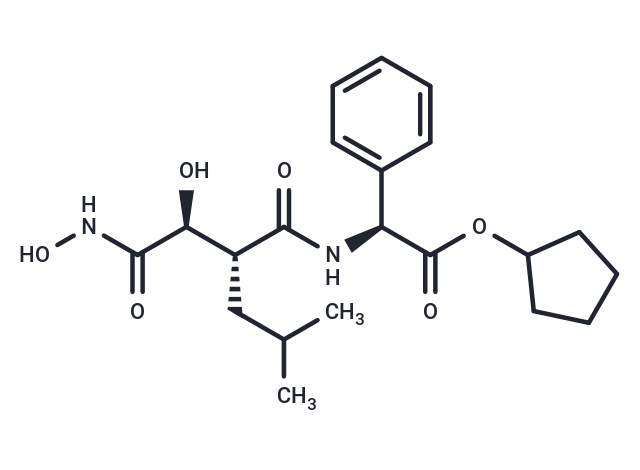Shopping Cart
Remove All Your shopping cart is currently empty
Your shopping cart is currently empty
Tosedostat (CHR-2797) is an orally bioavailable inhibitor of the M1 family of aminopeptidases with potential antineoplastic activity. Intracellularly converted into the poorly membrane-permeable active metabolite (CHR-79888), it inhibits puromycin-sensitive aminopeptidase (PuSA) and leukotriene A4 (LTA4) hydrolase. This inhibition in tumor cells may lead to amino acid deprivation, suppressed protein synthesis, increased proapoptotic protein Noxa levels, and ultimately, cell death.

| Pack Size | Price | USA Warehouse | Global Warehouse | Quantity |
|---|---|---|---|---|
| 1 mg | $50 | Inquiry | Inquiry | |
| 5 mg | $133 | - | In Stock | |
| 10 mg | $198 | Inquiry | Inquiry | |
| 25 mg | $372 | Inquiry | Inquiry | |
| 50 mg | $558 | Inquiry | Inquiry | |
| 100 mg | $836 | Inquiry | Inquiry | |
| 1 mL x 10 mM (in DMSO) | $117 | - | In Stock |
| Description | Tosedostat (CHR-2797) is an orally bioavailable inhibitor of the M1 family of aminopeptidases with potential antineoplastic activity. Intracellularly converted into the poorly membrane-permeable active metabolite (CHR-79888), it inhibits puromycin-sensitive aminopeptidase (PuSA) and leukotriene A4 (LTA4) hydrolase. This inhibition in tumor cells may lead to amino acid deprivation, suppressed protein synthesis, increased proapoptotic protein Noxa levels, and ultimately, cell death. |
| In vitro | In HL-60 cells, the treatmentwith Tosedostat (CHR-2797) results in an increase in the secretion of Stanniocalcin 2 (STC2) protein into the growth medium. After 2 h treatment with Tosedostat (60 nM), increases in SLC7A11 expression are detectable. The for by Tosedostat inhibits the proliferation of U-937 and HuT 78 cell lines (IC50s: 10 nM; >10 μM). Tosedostat treatment increases expression of amino acid deprivation response (AADR) genes in U-937 cells but not in HuT 78 cells. By 24 h with Tosedostat (0.01 μM) the mean MCA production is reduced to 77.8% of the untreated control cells; similarly the MCA production is reduced to 51.3% with 1 μM, 38.5% with 5 μM, and 35.3% with 10 μM Tosedostat. |
| In vivo | In vivo in rodent cancer models, Tosedostat (CHR-2797) has anticancer activity, and a dose-response relationship has been shown in two models. The effect of Tosedostat is less apparent when the tumor burden is higher before therapy. |
| Kinase Assay | Cells are seeded at a density of 4×104/mL, cultured for 24 h, then treated with 0.06 to 6 μM Tosedostat (CHR-2797) for 24 h. After treatment, 5×104 cells are washed with PBS and seeded in 100 μL Cys/Met-free RPMI 1640 containing Tosedostat, supplemented with 10% dialyzed FBS. 1.5 μCi [35S]Cys/Met (>1,000 Ci/mmol) is added, and incubation continued for 1 h at 37°C. Cells are captured onto 96-well GF/B filter plates and washed twice with PBS before precipitation with 10% ice-cold trichloroacetic acid (TCA) for 1 h at 4°C. Precipitated proteins are washed four times with ice-cold 10% TCA and air-dried for 1 h. UltimaGold scintillation cocktail is added and allowed to mix for 1 h before scintillation counting using a scintillation counter. |
| Cell Research | Tosedostat (CHR-2797) is stored at -20°C as a 10 mM stock in dimethyl sulfoxide (DMSO), and diluted with RPMI culture medium prior to use.Leukemic cells are washed and suspended in phosphate buffered saline (PBS). 100 μL of cell suspension (1×105 cells/mL) is mixed with 100 μL of Tosedostat (CHR-2797) (0.01 to 10 μM) and 200 μM L-alanine 4-methyl-coumaryl-7-amide (ala-MCA) in a 96 well plate in duplicate. The aminopeptidase activity is measured by detecting the fluorescent 7-amino-4-methylcoumarin (MCA) liberated from the cleavage of ala-MCA by cellular aminopeptidases (excitation 355 nm, emission 460 nm). |
| Animal Research | A breeding colony of NOD/SCID IL2R gammanull mice are used in this study. The mice are inoculated subcutaneously in the right flank with 2×106 H929 myeloma cells in 50 μL RPMI-1640 and 50 μL MatrigelTM Basement Membrane Matrix Growth Factor Reduced. The mice are assigned into the following four treatment groups (10 animals per group): no treatment, Tosedostat 75 mg/kg, CHR-3996 30 mg/kg, and Tosedostat 75 mg/kg with concomitant CHR-3996 30 mg/kg. Tosedostat is administered daily by intra-peritoneal injection beginning four days after the tumour cells are inoculated. Caliper measurements of the longest perpendicular tumour diameters (length) and width are performed every other day to estimate the tumour volume. |
| Synonyms | CHR-2797 |
| Molecular Weight | 406.47 |
| Formula | C21H30N2O6 |
| Cas No. | 238750-77-1 |
| Smiles | CC(C)C[C@H]([C@H](O)C(=O)NO)C(=O)N[C@H](C(=O)OC1CCCC1)c1ccccc1 |
| Relative Density. | 1.24 |
| Color | White |
| Appearance | Solid |
| Storage | keep away from moisture,store at low temperature | Powder: -20°C for 3 years | In solvent: -80°C for 1 year | Shipping with blue ice/Shipping at ambient temperature. | |||||||||||||||||||||||||||||||||||
| Solubility Information | DMSO: 55 mg/mL (135.31 mM), Sonication is recommended. | |||||||||||||||||||||||||||||||||||
| In Vivo Formulation | 10% DMSO+40% PEG300+5% Tween 80+45% Saline: 2 mg/mL (4.92 mM), Sonication is recommended. Please add the solvents sequentially, clarifying the solution as much as possible before adding the next one. Dissolve by heating and/or sonication if necessary. Working solution is recommended to be prepared and used immediately. The formulation provided above is for reference purposes only. In vivo formulations may vary and should be modified based on specific experimental conditions. | |||||||||||||||||||||||||||||||||||
Solution Preparation Table | ||||||||||||||||||||||||||||||||||||
DMSO
| ||||||||||||||||||||||||||||||||||||
| Size | Quantity | Unit Price | Amount | Operation |
|---|

Copyright © 2015-2026 TargetMol Chemicals Inc. All Rights Reserved.